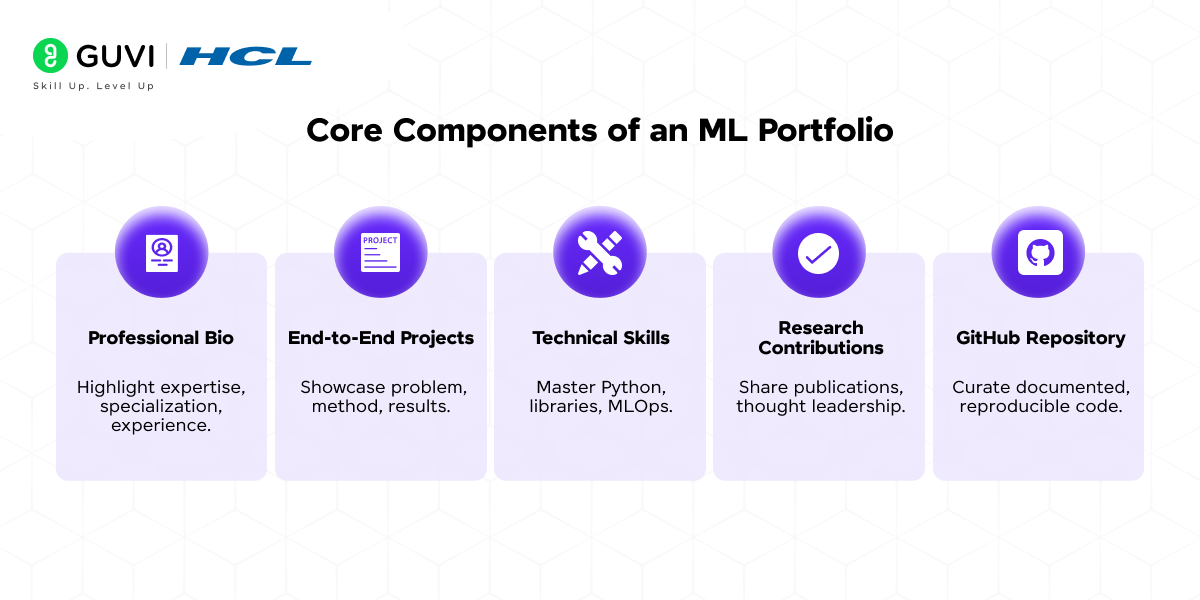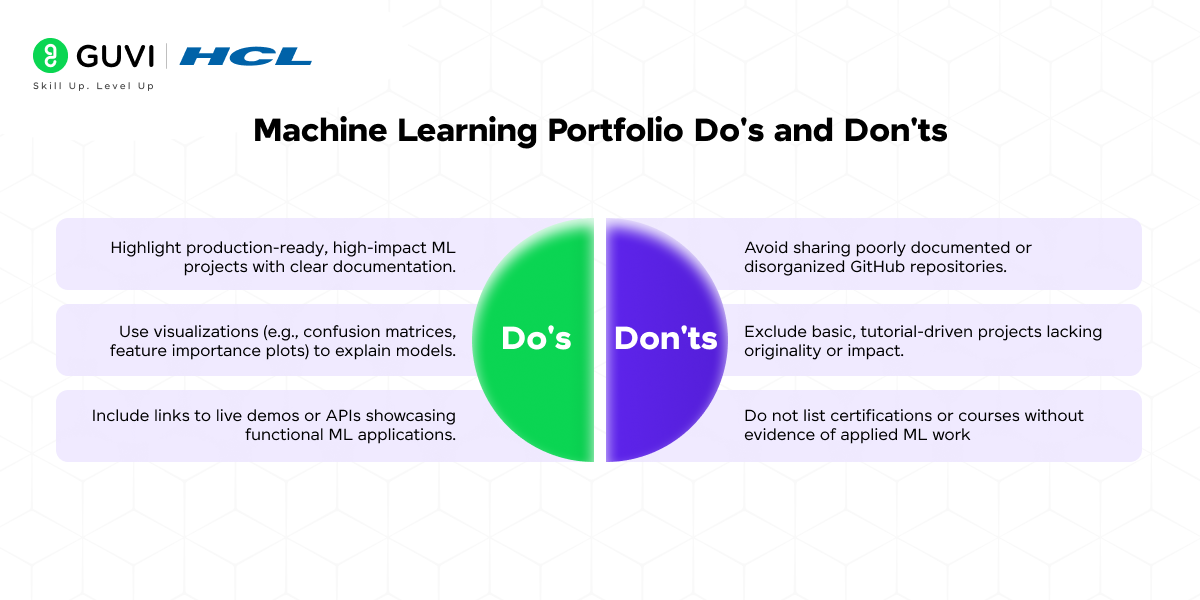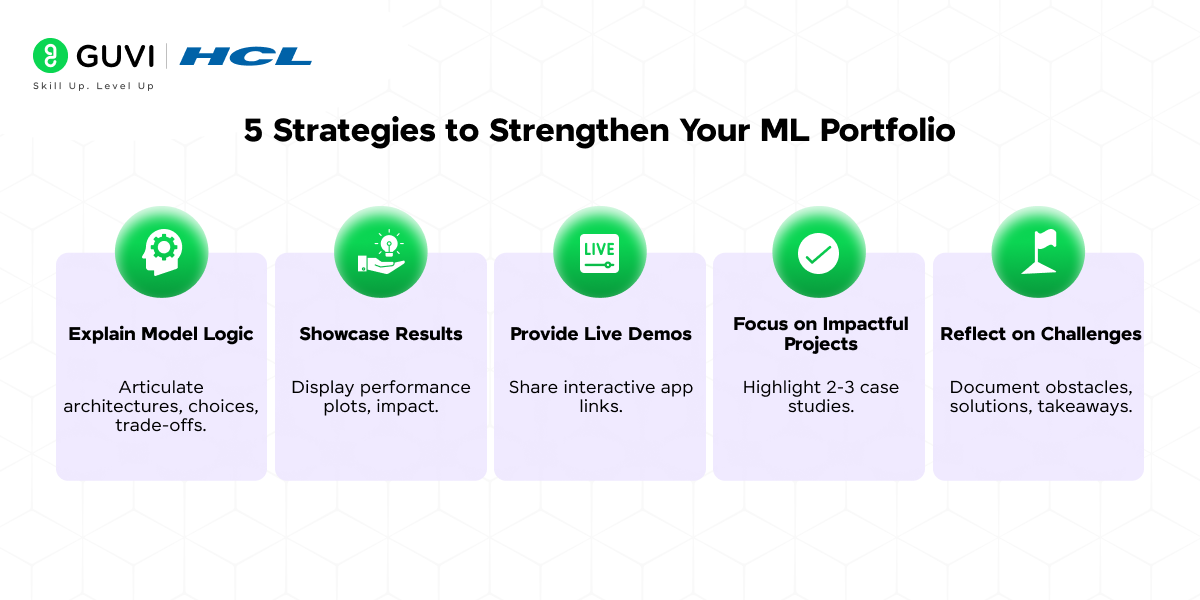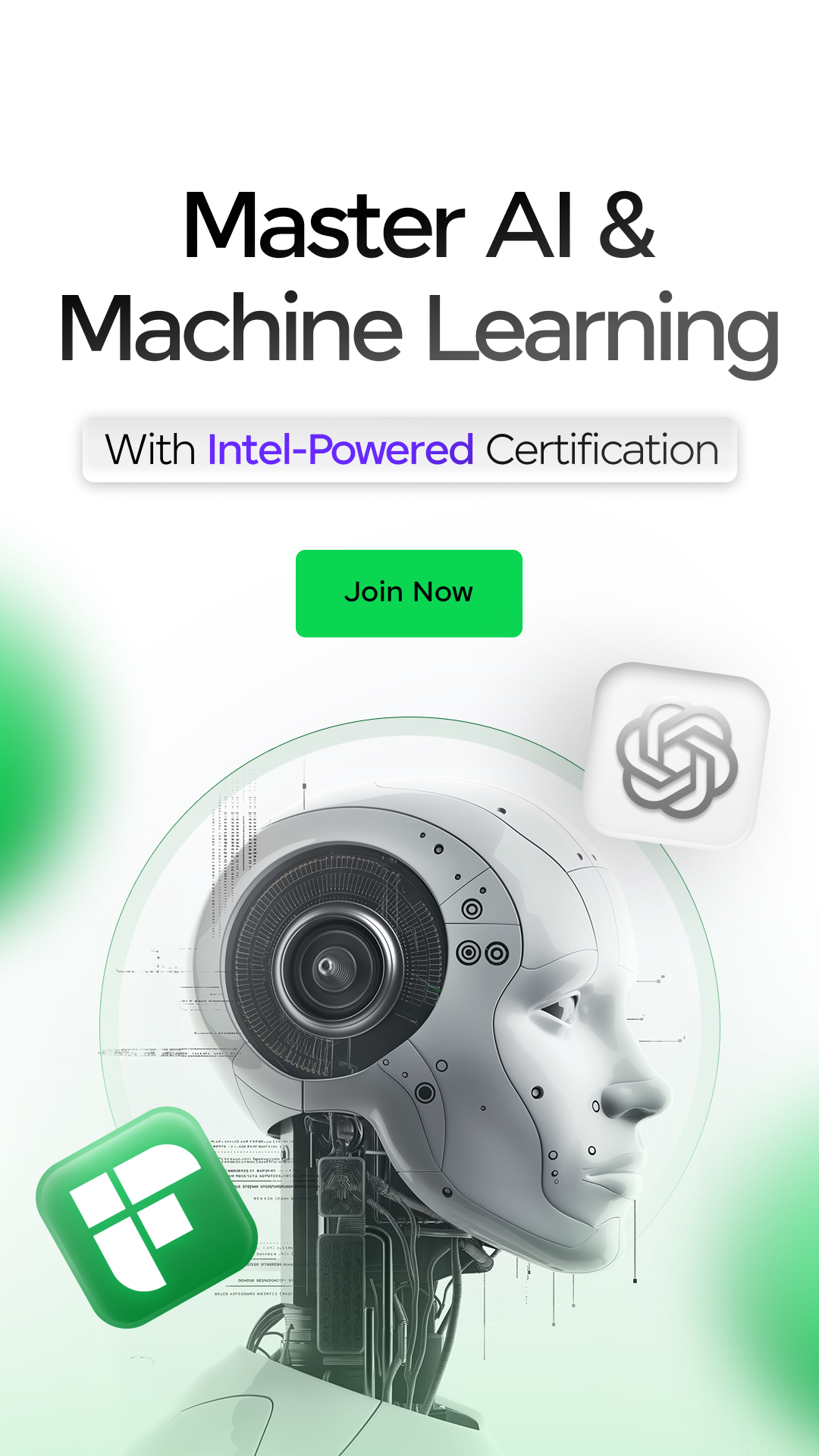
Machine Learning Professional Portfolio
Aug 04, 2025 7 Min Read 2816 Views
(Last Updated)
The Indian IT sector is expected to see 15-20% job growth in 2025, with ML-related roles surging by over 30% as companies double down on emerging technologies like generative AI, predictive analytics, computer vision, and automation.
So what does this mean for you?
As much as the demand is soaring, the competition is soaring faster. Thousands of candidates will be flooding the market with the same certifications, the same Udemy completions, and the same one-line resume claims like “Built ML models using Python.”
That’s where a Machine Learning Professional Portfolio becomes your game-changer.
It’s no longer about what you’ve learned – it’s about what you can prove.
In a crowded applicant pool, your portfolio is the one asset that shows recruiters, hiring managers, and even potential clients how you think, how you solve problems, and how well you can translate ML into real-world impact.
In this blog, you’ll learn:
- What exactly makes up a strong ML portfolio
- Why it’s more powerful than your résumé alone
- What mistakes to avoid (that silently kill your chances)
- How to make your work impossible to ignore
- And the kind of projects that can actually get you hired
If you’re serious about landing a role in Machine Learning, this post could save you months of guesswork. Let’s get into it.
Table of contents
- What Is a Machine Learning Professional Portfolio?
- Reasons to Have a Machine Learning Professional Portfolio in 2025
- Key Elements of a High-Impact Machine Learning Professional Portfolio
- What Not to Include in Your Portfolio
- What Not to Include in Your Machine Learning Professional Portfolio
- 8 Pro Tips to Make Your Machine Learning Portfolio Stand Out
- Wrapping Up
- FAQs
- How to make a machine learning portfolio?
- Is ML a good career path?
- Is machine learning worth in 2025?
- How to start with ML project?
- How do I create a digital student portfolio?
What Is a Machine Learning Professional Portfolio?
A Machine Learning portfolio is more than a list of skills or a gallery of code. It’s a strategic showcase of your work, projects, experiments, and implementations that prove your ability to turn machine learning concepts into real, working solutions.
It is your professional proof of work. It reflects how well you understand ML algorithms, how you approach problem-solving, and how effectively you can build, test, and deploy models that solve practical challenges.
From data preprocessing and model selection to performance evaluation and deployment, each entry in your portfolio tells a story – not just about what you’ve built, but also how you think like an ML engineer.
And most importantly, it gives potential employers or collaborators a clear, tangible sense of what you’re capable of, beyond your resume.
A solid ML portfolio bridges the gap between academic learning and industry readiness, and in 2025’s hyper-competitive landscape, it’s becoming a critical differentiator.
Reasons to Have a Machine Learning Professional Portfolio in 2025
We are here to burst your bubble of “Having a resume and an updated LinkedIn profile is more than enough”. We are here to convince you otherwise.
A few reasons your Machine Learning Portfolio would help you land your dream job like a cakewalk:
1. Applicant Tracking Systems (ATS) filter resumes based on keywords, often overlooking nuanced skills. A portfolio demonstrates hands-on expertise in Python, TensorFlow, or NLP, which ATS may miss.
Recruiters value tangible evidence of skills. For instance, a project on GitHub showcasing a churn prediction model or a computer vision application instantly validates your capabilities.
2. India’s ML job market is booming, with 30-35% growth in roles like ML engineer and data scientist in 2025. However, competition is fierce, with thousands of graduates and global talent vying for positions.
A portfolio highlights unique projects, such as a recommendation system or anomaly detection model, setting you apart from candidates with similar resumes.
3. Employers seek candidates who can handle the whole Machine Learning pipeline, data preprocessing, model training, deployment, and evaluation.
A portfolio showcasing projects with clear documentation (e.g., a Kaggle notebook with EDA, model selection, and results) proves you can solve real-world problems.
4. With 63% of Indian workers needing reskilling by 2030, recruiters prioritize candidates with proven, up-to-date skills.
A portfolio with recent projects (e.g., using 2025-relevant tools like PyTorch or explainable AI frameworks) signals you’re current with industry trends.
5. Machine Learning is evolving rapidly, with demand spiking in NLP (market to hit $158 billion by 2032), computer vision, and AI ethics.
A portfolio featuring projects in trending areas like explainable AI or generative AI positions you as a forward-thinking candidate.
6. India’s 4,000+ AI startups and growing freelance market create demand for project-based ML work.
A portfolio acts as your golden ticket for freelance clients or startup founders, showcasing your ability to deliver solutions.
And if you are still lingering with doubts on whether you should actually invest your time, research hard, sift through endless GitHub repos, dig into deployment tools, polish every project detail, and build something that feels more exhausting than your final semester thesis, we get it.
We’ve got you.
Dive into the next section as we break it down for you – the key elements you must include, and the common mistakes you absolutely shouldn’t.
Key Elements of a High-Impact Machine Learning Professional Portfolio

A strong ML portfolio isn’t just an optional add-on; it’s your primary differentiator.
Recruiters in cities like Bengaluru, Hyderabad, and Pune are scanning portfolios to find candidates who can go beyond theoretical knowledge and deliver real, production-ready impact. Let’s break down the non-negotiable elements your portfolio must include — and how to take each one from good to unforgettable.
- About Me & Career Focus
What to Include: A crisp, compelling snapshot of who you are, your ML journey, and your career direction. Be specific about your domain interest — whether it’s NLP, CV, MLOps, or ethical AI. Tailor this to industry demands and emerging opportunities.
Why It Matters: Recruiters are filtering for clarity and fit. A focused, purpose-driven introduction shows that you’re not just exploring ML, you’re building for a reason.
Pro Tip: Mention a moment or problem that drew you to ML. It humanizes your story. Link to your LinkedIn or portfolio site for depth.
Example:
“B.Tech graduate turned ML engineer, driven by the challenge of building interpretable AI models for healthcare. Passionate about using data science to solve real-world inefficiencies in India’s digital health infrastructure.”
- Projects With Context
What to Include: Showcase 3 – 5 projects, each highlighting a different facet of your ML skills. Explain the “why,” “how,” and “what happened.” Focus on high-ROI areas like fraud detection, churn prediction, sentiment analysis, and recommendation engines.
Why It Matters: In a competitive market, project storytelling is the hook. Recruiters want to know: Can you take data, apply the right algorithm, and deliver results that matter?
Pro Tip: Add context + results + stack. Use Streamlit or Gradio to create interactive demos and dashboards.
Example:
“Built a real-time churn prediction engine using Random Forest for an e-commerce startup. Reduced churn by 15%. Hosted on Heroku with an interactive dashboard.”
- Data Pipelines & Feature Engineering
What to Include: Highlight projects where you handled raw data end-to-end. Talk about tools (e.g., Airflow, Spark), techniques (e.g., SMOTE, PCA), and your logic behind choosing features.
Why It Matters: Anyone can run models on cleaned datasets. But if you can wrangle messy data, build scalable pipelines, and improve model quality, you’re in another league.
Pro Tip: Include diagrams of your data flow. Show how you processed large volumes or automated ETL tasks.
Example:
“Built a Spark-based pipeline to detect fraudulent transactions in real-time. Feature engineering reduced false positives by 10%.”
- Deployment & MLOps
What to Include: Show how you take models beyond Jupyter. Include tools like Flask, FastAPI, Docker, GitHub Actions, and Prometheus. Highlight A/B testing, model monitoring, and retraining logic.
Why It Matters: In 2025, companies want ML engineers who can ship. MLOps is where theory becomes value.
Pro Tip: Add a short Loom video demo or live link. Mention optimization — speed, cost, or scale.
Example:
“Deployed a text classification API using FastAPI and Docker on AWS EC2. Monitored model drift with Prometheus + retraining every 10k inputs.”
- GitHub: Signal > Noise
What to Include: A few high-quality, production-grade repos are worth more than a dozen messy ones. Prioritize documentation, modular code, and test coverage.
Why It Matters: Recruiters look at your GitHub to assess professionalism, not quantity. Think of it as your open-source resume.
Pro Tip: Add CI/CD badges, Colab notebooks, and make your README shine.
Example:
“YOLOv8-based vehicle detection repo, includes Dockerfile, inference API, and test cases. README includes model card and sample outputs.”
- Public Work: Blogs, Talks, Research
What to Include: Any content where you’ve shared knowledge — articles, workshops, hackathons, or papers. Discuss topics like fairness in AI, LLM fine-tuning, or federated learning.
Why It Matters: Visibility and thought leadership matter. If you’ve taught, published, or spoken, it proves your depth.
Pro Tip: Link recordings, add SEO-friendly blog titles, and write on trending keywords like “LangChain”, “TinyML”, or “RAG pipelines.”
Example:
“Published a blog on ‘RAG Architecture in Enterprise Search’ on Medium; 5K+ views, reshared by IndiaAI.”
- Tools & Tech Stack
What to Include: List your proficiency level for every key tool or framework. Think: “Intermediate in PyTorch and Docker, advanced in Scikit-learn and Pandas.”
Why It Matters: The 2025 ML job market favors stack versatility. Tailor it to your focus: NLP folks might highlight Hugging Face; deployment engineers might focus on Kubernetes and cloud.
Pro Tip: Add a visual stack chart. Mention certifications like AWS ML, TensorFlow Developer, or Google Data Engineer.
Example:
“Experienced with LangChain for LLM apps, Apache Airflow for pipeline orchestration, and Hugging Face Transformers for fine-tuning BERT models.”
- Certifications That Signal Skill (Not Just Study)
What to Include: Highlight certifications that hold weight in the ML hiring world — think AWS Certified Machine Learning – Specialty, Google Professional ML Engineer, TensorFlow Developer, or standout courses from Coursera, edX, or GUVI that involve real-world projects.
Why It Matters: Certifications don’t guarantee skill, but when paired with a strong portfolio, they reassure recruiters that you understand ML from both a theoretical and applied angle. Especially if you’re switching domains or don’t have a CS degree, certs can give your profile legitimacy.
Pro Tip: Don’t overload your resume with 10+ badges – 2–3 solid ones are enough when backed by demonstrable work.
Example:
“Completed the AWS ML Specialty Certification — built and deployed an ML model using SageMaker to forecast sales for a retail dataset. Also certified in GUVI’s AI & ML course, with 12 real-world projects included.”
What Not to Include in Your Portfolio

Opportunities don’t knock on your door twice, and in this hyper-fast and attention-deficient era, a million-dollar opportunity knocking even once is a rarity.
So, with your machine learning professional portfolio, how are you going to seal the deal?
Simple – by completely avoiding all the rookie mistakes. Before you even open that tab in your mind, here’s an all-sorted list of what you should be avoiding.
What Not to Include in Your Machine Learning Professional Portfolio
1. Projects That Don’t Speak Machine Learning
If it doesn’t involve ML concepts or data science techniques, don’t add it. Basic web pages, scripts with no data work, or projects that don’t apply ML algorithms show a lack of focus. Your portfolio should scream ML, not “I dabbled in coding.”
Example: A static website or a Python script that only prints text adds zero value. Instead, highlight projects with clear data inputs, feature engineering, and modeling.
2. Poorly Documented Projects
A project without context is meaningless. Your code must be accompanied by a thorough README file explaining:
- The problem you addressed
- The dataset used (source, size, nature)
- Your approach (models, feature engineering, validation methods)
- Key results and their significance
Minimal documentation signals laziness or poor communication skills – both deal breakers.
3. Copy-Paste Tutorial Projects Without Originality
Simply replicating a common tutorial project does not demonstrate skill or initiative. Examples like the Titanic survival prediction or MNIST digit classifier are basic starting points, but don’t impress unless you:
- Tweak the dataset significantly
- Use novel features or methods
- Show deeper analysis or improved results
Without these, your portfolio looks like a beginner’s homework submission.
4. Proprietary or Confidential Work
Avoid posting any code or data bound by non-disclosure agreements. Instead, write a concise project summary highlighting your contributions and impact without exposing sensitive information.
Example: “Built a real-time anomaly detection system for a financial services client that reduced fraud cases by 15%.”
5. Unpolished or Broken Code
Clean, modular, and executable code is essential. Messy scripts, hard-coded values, lack of functions, or broken notebooks convey poor coding discipline and professionalism. Test your code thoroughly before sharing.
6. Vague or Generic Descriptions
“Built a model” is meaningless. Quantify and specify:
- What problem? (e.g., predicting customer churn)
- What data? (e.g., 20,000 records from telecom customers)
- What methods? (e.g., random forest, hyperparameter tuning)
- What results? (e.g., 87% accuracy, reduced false positives by 10%)
This precision makes your work credible and impressive.
7. Outdated or Narrow Techniques
Only using linear regression or simple clustering won’t cut it anymore. Show awareness of current standards: deep learning frameworks (TensorFlow, PyTorch), transfer learning, cloud ML services, and MLOps practices. It signals you’re up to speed with industry trends.
8. Unfinished or Overly Complex Projects
An incomplete project with no results is a deal breaker. Conversely, a project so complex it’s hard to explain loses the recruiter’s attention. Choose projects you can present, explain, and demonstrate outcomes for.
9. Exaggerated Claims
Don’t inflate results or misrepresent your role. Claiming 99.9% accuracy without explaining data balance or validation strategy is suspicious. Be honest and transparent – credibility matters more than inflated numbers.
10. Unprofessional Presentation
Broken links, inconsistent formatting, poor grammar, or missing visuals hurt your impression. A polished, well-organized portfolio reflects your attention to detail and communication skills.

8 Pro Tips to Make Your Machine Learning Portfolio Stand Out
- Create a Personal Portfolio Website
Use platforms like Notion, GitHub Pages, or Webflow to host a clean, navigable personal site. This centralizes your projects and gives a professional impression beyond just GitHub repos. - Incorporate Visuals That Tell the Story
Add clear visuals – model architectures, data flow diagrams, dashboards, and key performance metrics. Visual aids help recruiters quickly grasp the complexity and impact of your work. - Narrate Your Process Thoroughly
Explain your journey: problem definition, dataset challenges, modeling iterations, and failure points. Sharing your problem-solving mindset shows depth beyond final results. - Link to Live Applications or APIs
Whenever possible, include links to live demos, web apps, APIs, or interactive Colab notebooks. This demonstrates real-world deployment and practical usability. - Keep Your Portfolio Fresh and Updated
Regularly add new projects, update old ones with improved models or better documentation, and remove outdated or irrelevant work. An active portfolio signals continuous learning. - Show Version Control History and Progress
Use Git commit history to highlight how your project evolved—bug fixes, refactoring, performance improvements. This showcases discipline and coding maturity. - Highlight End-to-End Workflow Skills
Display skills across the ML pipeline: data cleaning, feature engineering, model selection, hyperparameter tuning, deployment, and monitoring. Employers want well-rounded practitioners. - Include Real-World or Business Impact Statements
Quantify how your project made a difference, e.g., “Reduced model inference time by 30%,” or “Improved churn prediction accuracy leading to a 10% customer retention boost.” Numbers speak.
Want Projects That Impress Recruiters?
A solid ML portfolio needs more than just theory, it needs real-world projects that prove your skills.
That’s exactly what GUVI’s Artificial Intelligence and Machine Learning Course offers. It’s hands-on, project-focused, and designed to help you build deployable applications using tools like Python, TensorFlow, and NLP libraries.
If you’re stuck in tutorial loops and want portfolio-ready projects that recruiters will notice, this is your shortcut.
Wrapping Up
Before you jump into your favorite software to create your portfolio, here’s a final takeaway-
Information overload is a big turn-off for your potential client or recruiter. Read the job descriptions and requirements thoroughly, then customize your machine learning professional portfolio accordingly. It is not one size fits all.
Focus on showcasing the skills and projects that directly align with the role you want. Keep your presentation clear, concise, and relevant. Tailoring your portfolio this way shows that you understand the company’s needs and are ready to deliver value from day one.
Remember, quality and relevance always beat quantity. Make every project count, and your portfolio will speak volumes on your behalf.
FAQs
1. How to make a machine learning portfolio?
Start with 3–5 real-world projects that solve clear problems. Showcase data cleaning, modeling, and deployment. Host them on GitHub with clean code, detailed READMEs, and visual insights.
2. Is ML a good career path?
Yes, machine learning offers high-paying roles, fast-growing demand, and cross-industry applications. It combines coding, data, and problem-solving — ideal for tech enthusiasts aiming to stay future-relevant.
3. Is machine learning worth in 2025?
Absolutely. In 2025, ML continues to power innovations in healthcare, finance, retail, and more. With AI adoption rising, skilled ML professionals remain in high demand globally.
4. How to start with ML project?
Pick a simple, real-world problem. Gather data, explore patterns, build a model, and evaluate results. Start small — document everything. Then iterate and scale with added complexity.
5. How do I create a digital student portfolio?
Use platforms like Notion, GitHub Pages, or a simple website. Include your top projects, skills, resume, and contact info. Make it clean, organized, and easy to navigate.





























Did you enjoy this article?